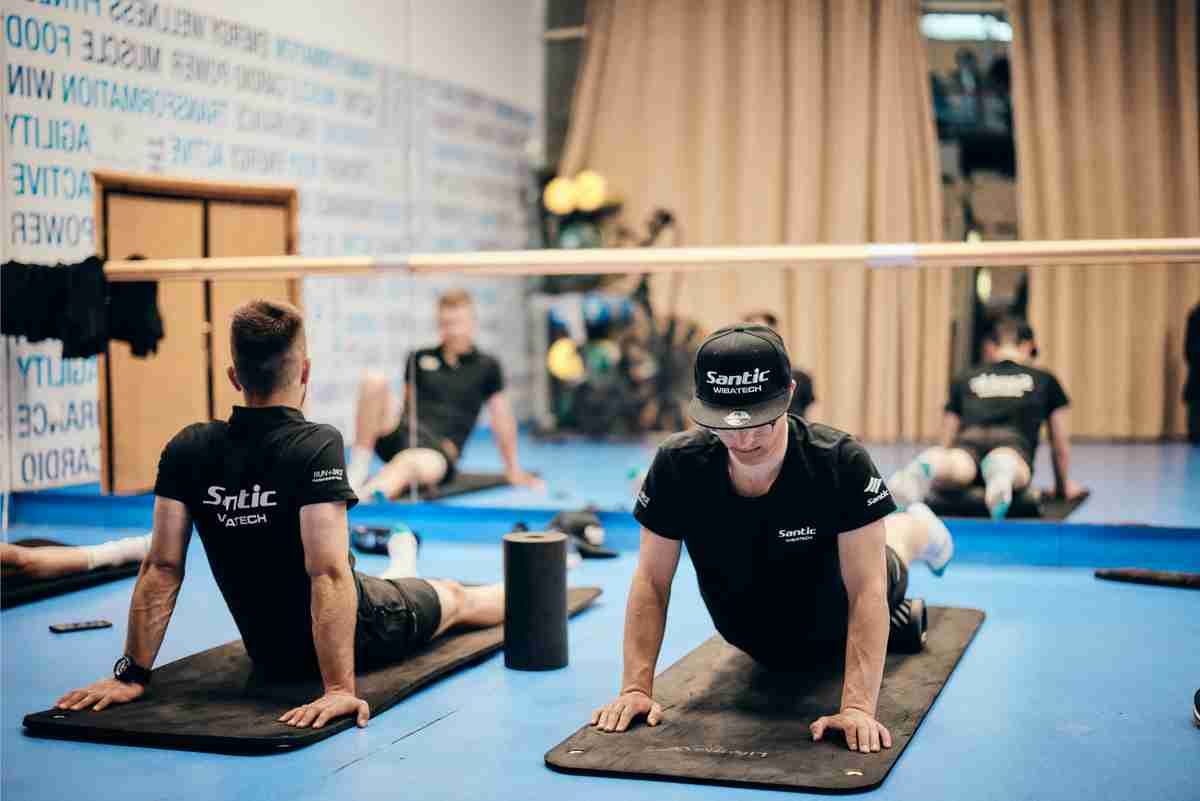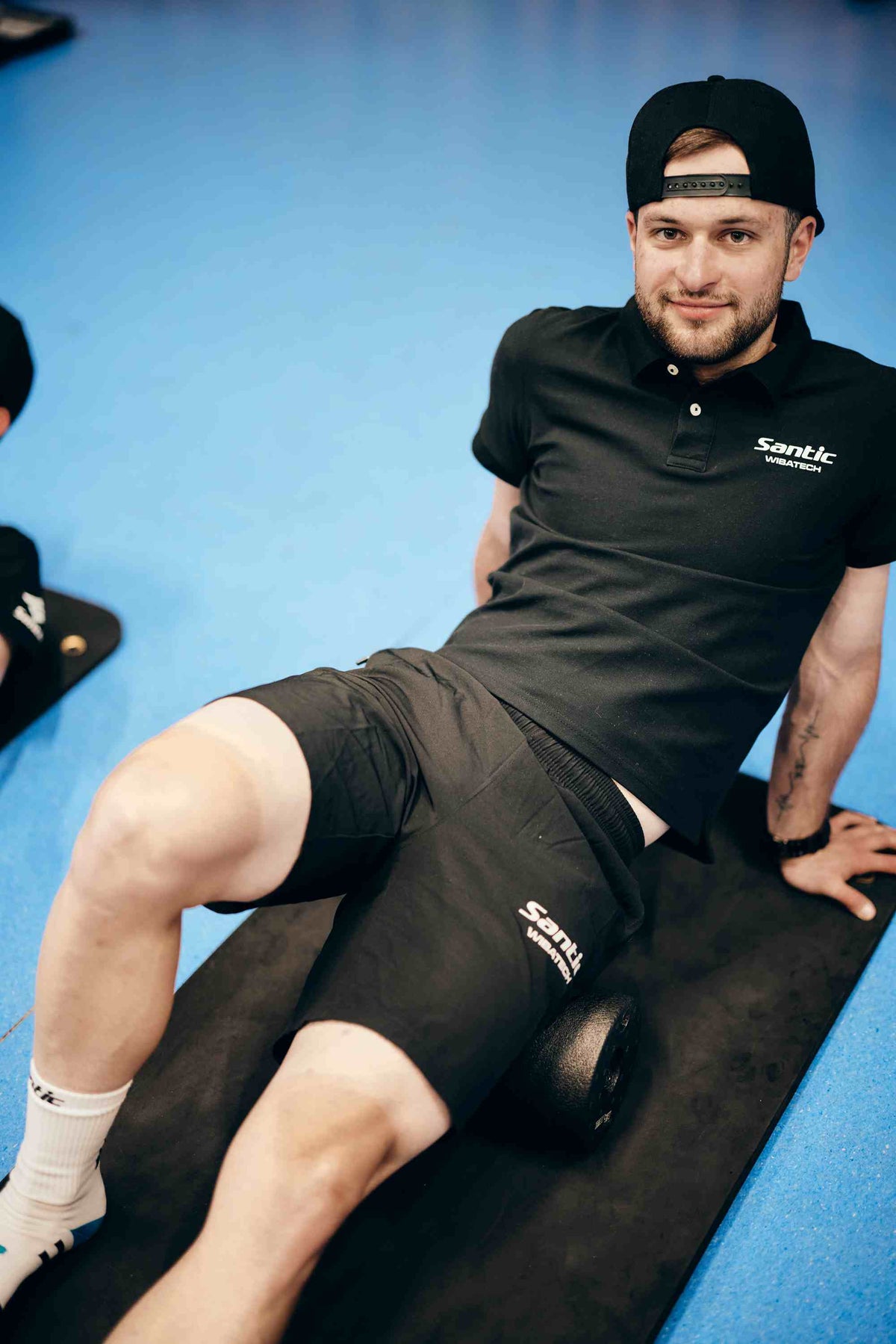SCyclists will stretch more than other athletes. It's rare to find a cyclist who doesn't put in some time on the stationary bike if they have a choice. But cycling requires a specific range of motion and flexibility that may differ from other sports. Cyclists need different stretches to stay limber for the ride ahead.
But first, let us go through these questions before we get started:
Stretching Q&A
1. When should I stretch?
It is best to stretch after a ride. When tension builds up in your muscles, your body puts on more layers of muscle tissue and tightens up, causing injury. Stretches for cycling allow blood to flow more freely, making your muscles warm and pliable.
Stretching also improves flexibility and range of motion, which helps with pedaling efficiency. The key is finding the time to stay loose yet not tight after a ride.
If you are already physically tired from cycling, it is better to use this time for sleeping or other relaxation activities than stretching.
2. How long should I stretch for?
It depends on how long your ride was, how much you stretched and what you stretched. If you stretched for 45 minutes and rode for 90 minutes, your body is already pretty warm, so stretching further may not be necessary. However, if you only stretched for 15 minutes and then rode for 90 minutes, your body would be cooling off considerably, so stretching well is more important than usual.
Stretching should also go hand in hand with warming up before a ride. Stretch lightly first before pedaling hard. Do some light jogging or stationary bike riding that does not involve any rotation of the legs, such as spinning the pedals backward or the bike spinning in place.
3. How many stretches should I do?
Stretching isn't an all-day activity, but you should stretch early in the morning or the day after your ride. You can do a few stretches before your ride to get loose and then stretch after the ride to cool down.
Try an active cool-down with a combination of light jogging and stretching. Stay away from static stretches right after a workout because they can cause you to lose flexibility. Save those for the evening or the next morning when you wake up.
4. How far should I stretch?
The length of your stretch depends on how tight your muscles are and whether or not you are injured. Here is where you have to use common sense. A 2-minute range of motion will be good for most cyclists. But this may vary based on individual factors such as flexibility and injury history. Stretching before a hard workout might be also enough if you know that you don't need to stretch further after the workout.
You can do some static stretches before a ride, but don't stretch longer than 10 minutes with several cycles of extension and flexion to avoid injury.

Stretches for cyclists
The best stretches for cyclists require you to control your movements – passive stretches involving other people pushing or pulling you. That's because the best stretches for cyclists should focus on specific muscles and joints to help cyclists ride longer distances and at higher speeds without injury.
Learning how to stretch is just as important as increasing the range of motion in your joints. Many people neglect stretching, but it is just as important as practicing any other aspect of cycling.
The following 11 stretches improve flexibility in different parts of a cyclist's body, whether the shoulders or knees, legs or neck.
1. Calf stretch into a wall
Whether you're looking for a calf stretch or a calf muscle stretch, this exercise is both. This passive stretch relies on the wall to hold you in place while you lower or raise your leg.
It is an effective way to warm up before a ride and can be done with one or two legs depending on your flexibility goals or injury concerns.
Doing this exercise correctly is important by keeping your heel flat against the wall and bending at the knee during the stretch.
Maintaining control of your muscles and joints through this process will help increase flexibility and range of motion, making cycling more comfortable and keeping injuries to a minimum.
2. Downward facing dog
The downward-facing dog is an easy stretch that you can use as an active stretch by holding it for 30 seconds and then doing several repetitions. If you hold it for 2 minutes, it becomes a static stretch.
It is also important to keep your back straight as part of the static stretch is to strengthen the muscles at the base of your back and your shoulders. You will likely feel this in your lower and upper back, but remember that you can keep these muscles strong by holding this position for 2 minutes a few times a week.
The downward-facing dog stretches your hamstrings and quadriceps simultaneously, two common trouble areas for cyclists who spend a lot of time on their bikes each week.
3. Expanded leg pose
This stretch is ingenious – it's also great for runners or swimmers. You can use this as an active stretch or a static one (holding it for 10 seconds).
Do a few reps of knee extension while holding the position. You will increase the strength and flexibility in your quadriceps, hip flexors, and ankle dorsiflexion, which means you can handle greater forces in your leg during cycling.

4. Standing quad stretch
It is a static stretch that focuses on the quadriceps. You can do this by standing next to a table and holding your arms at a 90-degree angle.
You will feel this stretch in the front of your thighs and calves, as well as your chest and shoulders.
You can do the stretch regularly to build strength in the quad muscles and prevent injury.
5. Camel pose
The stretch is great while standing up, but you can also do it while lying down with a blanket or towel under the hips.
Depending on your preference, you can start with either a quarter-turn or a full turn.
Start in the low lunge position with your right ankle on the ground, keeping the right knee bent and left leg straight. Lean forward until you feel a gentle stretch in your right hip joint. Hold each side for one breath while you hold here and repeat this on the left side.
6. Seated glute stretch and hip opener
If you want to elongate your hip flexors and increase flexibility in your hips, do the seated glute stretch first. It is a good active stretching position that is easy to do on a bicycle.
Settle on the edge of your seat with your legs straight out behind you, and your arms stretched out in front of you. Inhale as you bend at the hip and move your torso forward until your hands reach the floor.
Move your arms back to the starting position and repeat for 4-6 breaths. Step off your seat, switch legs, and repeat for the opposite side of your body, making sure to keep your back straight.
Now that you have opened up the hips, you can do a quick hip opener to increase flexibility in your hips by pressing the knees into your chest while keeping the shoulders square.

7. Revolved belly pose
The revolver abdominal exercise is a great active stretch for cyclists that is quick and easy.
You can begin by sitting upright in a chair or on the edge of a stool at least 18 inches from the ground. Stretch your legs flat with your knees and your hands on your thighs, pointing the palms down towards your feet.
Keeping still, slowly rotate your upper body forward (against gravity) until you reach arm's length from the floor. Keep both shoulders square as you rotate, so you're not arching over.
8. Supported bound angle pose
Here's an active stretch that focuses on your flexibility of the spine and shoulders. It also strengthens the lats and chest muscles.
To do this stretch, sit on a chair with a straight back. You can use a yoga strap to help you hold your legs if you need to, or feel free to place your hands behind you at the base of your spine.
Next, lengthen your spine as much as possible with as few movements as possible by pressing the hands and feet into the floor and pushing out through the heels. It will take concentration.
9. Seated Hamstring Stretch
The seated hamstring stretch is an active stretch that focuses on taking the hips through a large range of motion and strengthening the legs by keeping them straight.
You can perform the exercise by sitting on the edge of a couch or chair and bending one leg at a time with the other leg flat on the ground.
The one-legged hamstring stretch targets your hamstrings but also works your gluteus maximus. It is a good regular stretch as you sit for long periods at work when commuting or watching television.

10. Plantar Fascia Stretch
The plantar fascia stretch is one of the most important stretches to do regularly – it's an active stretch that focuses on stretching the plantar fascia but also strengthens the ankles by using them as part of the exercise.
It is recommended after your ride when you're cool-down and cooling down your muscles, but you can take the time to focus on your feet for a few minutes. It will help prevent injury.
Sit straight back with your knees at 90 degrees (or even higher) without locking your knees. If you cannot achieve this position with good posture, stop immediately and find a different chair or surface that allows you to keep good posture.
Take a few seconds to ensure your feet are flat on the floor and that you are maintaining good posture. Slowly bring your heel up as high as possible while maintaining good posture. You should feel this stretch in the front of the calf and back of the thigh.
Repeat this stretch for 30 seconds on each leg, making sure you don't let the extended leg go straight. If doing this exercise in a seated position, change legs after 30 seconds to complete one set of 30-second stretches on each leg.
11. Glute Stretch
This static stretch is an active exercise that focuses on stretching the gluteus medius and maximus. It also strengthens the hip abductors and flexors.
To get started with this stretch, kneel with one knee on a soft surface like a mat or rug and put your other leg straight so it's directly in line with the other knee.
If you need assistance, you can place your hands on something solid like a chair or car to help you balance. Once you have your balance, let go of the object and slowly sit down onto your butt as far as possible while keeping both knees straight. You should feel this stretch in your hip and the outside of your thigh to your calf.

Cycling is a great exercise but can be difficult on the body if you don't take time to stretch the stressed muscles during your ride.
While there are many stretches you can do after each cycle to ensure your safety, these are the most important 11 active stretches for cyclists that help open up the hips and elongate hip flexors, so they don't become tight and cause injury while riding. There are pre-ride stretches for cyclists on the list, such as glute stretches.
Now that you know how to start stretching after bicycling, you can start enjoying a more active lifestyle on and off your bike.
Related Articles
【Trainer at Home vs Cycling at Gym】
https://santic.com/blogs/extra/trainer-at-home-vs-cycling-at-gym
【Indoor Cycling Trainers】
https://santic.com/blogs/extra/indoor-cycling-trainers
【Cycling vs Running】
https://santic.com/blogs/extra/cycling-vs-running
【Indoor Cycling Accessories】
https://santic.com/blogs/extra/indoor-cycling-accessories



